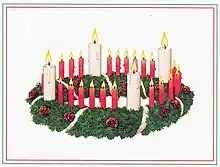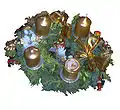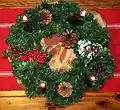Advent wreath
The Advent wreath, or Advent crown, is a Christian tradition that symbolizes the passage of the four weeks of Advent in the liturgical calendar of the Western church. It is traditionally a Lutheran practice, although it has spread to many other Christian denominations.[1][2][3]


It is an evergreen wreath with four candles, sometimes with a fifth, white candle in the center. Beginning with the First Sunday of Advent, the lighting of a candle can be accompanied by a Bible reading, devotional time and prayers.[4][5] An additional candle is lit on each subsequent Sunday until, by the last Sunday of Advent, all four candles are lit. Some Advent wreaths include a fifth, Christ candle which is lit at Christmas Eve or Christmas Day.[6] The custom originated in family settings but has also become widespread in public worship.
History
The concept of the Advent wreath originated among German Lutherans in the 16th century.[7] However, it was not until three centuries later that the modern Advent wreath took shape.[8]

Research by Prof. Haemig of Luther Seminary, St. Paul, points to Johann Hinrich Wichern (1808–1881), a Lutheran pastor in Germany and a pioneer in urban mission work among the poor, as the inventor of the modern Advent wreath in the 19th century.[9] During Advent, children at the mission school Rauhes Haus, founded by Wichern in Hamburg, would ask daily if Christmas had arrived. In 1839, he built a large wooden ring (made out of an old cartwheel) with 24 small red and 4 large white candles. A small candle was lit successively every weekday and Saturday during Advent. On Sundays, a large white candle was lit. The custom gained ground among Protestant churches in Germany and evolved into the smaller wreath with four or five candles known today. Roman Catholics in Germany began to adopt the custom in the 1920s, and in the 1930s it spread to North America.[10] Professor Haemig's research also indicates that the custom did not reach the United States until the 1930s, even among German Lutheran immigrants.
In medieval times Advent was a period of fasting during which people's thoughts were directed to the expected second coming of Christ; but in modern times many have forgotten this meaning and it has instead been primarily seen as the lead up to Christmas, and in that context the Advent wreath serves as a reminder of the approach of the feast.
In 1964, an Advent crown, made at home from wire coathangers and tinsel, appeared on the bi-weekly children's TV program Blue Peter. This 'make' became one of the program's most iconic, repeated each year, and was the introduction of this tradition to most of the broadly Anglican audience.[11] In later years, the candles were replaced by baubles, out of concern over fire.
More recently, some Eastern Orthodox families have adopted an Advent wreath with six candles, symbolizing the longer Christmas fast in Orthodox tradition, which corresponds to Advent in Western Christianity.[12]
Christian symbolism in the Advent wreath
Advent wreaths are circular, representing God's infinite love, and are usually made of evergreen leaves, which "represent the hope of eternal life brought by Jesus Christ".[13] Within the Advent wreath are candles that generally represent the four weeks of the Advent season as well as "the light of God coming into the world through the birth of Jesus Christ" although each of the candles can be attributed its own significance as well.[13] The four candles of the Advent wreath specifically symbolize the Christian concepts of hope, peace, joy and love, with these candles being lit subsequently throughout each week of the Advent season.[14][15][16][17] Many Advent wreaths also have a white candle in the centre to symbolize the arrival of Christmastide, which is known as the 'Christ candle'.[18] It is first lit on Christmas Eve, the beginning of Christmastide and may be lit throughout the rest of the Christmas season, as well as during Epiphanytide.[18] The Christ candle is coloured white because this is the traditional festal colour in the Western Church.[19] An additional layer of meaning names the first candle as the Messiah[20] or Prophecy[21] candle (representing the prophets who predicted the coming of Jesus), the second is the Bethlehem candle (representing the journey of Joseph and Mary), the third represents the shepherds and their joy, and the fourth is the Angel's candle, representing peace.[20]
In many Catholic and Protestant churches, the most popular colours for the four surrounding Advent candles are violet (or blue) and rose, corresponding with the colors of the liturgical vestments for the Sundays of Advent. For denominations of the Western Christian Church, violet is the historic liturgical color for three of the four Sundays of Advent as it is the traditional color of penitential seasons; blue has been historically used too, as it represents hopefulness, reflective of the theme of Advent surrounding the First Coming of Jesus and Second Coming of Jesus.[22][16] Rose is the liturgical color for the Third Sunday of Advent, known as Gaudete Sunday (from the Latin word meaning "rejoice ye", the first word of the introit of this Sunday); it is a pause in the penitential spirit of Advent.[23][24] As such, the third candle, representing joy, is often a different color from the other three.[16][14]
In other Protestant churches, especially in the United Kingdom, it is more common for Advent wreaths to have four red candles (reflecting their traditional use in Christmas decorations).[25] An Advent wreath given to Pope Benedict XVI of the Catholic Church also had four red candles.[26] In the UK, the four red advent candles are often linked to the Sunday Revised Common Lectionary readings for Advent, each candle representing those looking forward to the coming of Christ: the hope of all God's people (week one), the Old Testament prophets (week two), John the Baptist (week three) and Mary the mother of Jesus (week four).[27][28]
In Making God Real in the Orthodox Christian Home, Anthony Coniaris states that an Eastern Christian wreath consists of six different colored candles on a round base to celebrate the six weeks of the 40-day Advent and Christmas period. A green candle, symbolizing faith, is lit on the first Sunday that begins on November 15; on the second Sunday, a blue candle, symbolizing hope, is lit; on the third Sunday, a gold candle, symbolizing love; on the fourth Sunday, a white candle, symbolizing peace; on the fifth Sunday, a purple candle, symbolizing repentance; on the sixth Sunday, a red candle, symbolizing communion.[29]
References
- Peter C. Bower (January 2003). The Companion to the Book of Common Worship. Office of Theology and Worship, Presbyterian Church (U.S.A.). ISBN 9780664502324. Retrieved 2010-12-02.
It apparently emanated from the Lutheran tradition, but it has been appropriated by almost all other traditions.
- John Trigilio, Kenneth Brighenti (January 2007). The Catholicism Answer Book: The 300 Most Frequently Asked Questions. Sourcebooks. ISBN 9781402232299. Retrieved 2010-12-02.
Historically, the Advent wreath is a Lutheran custom dating back three hundred years ago.
- Carl Seaburg (30 April 2003). Celebrating Christmas: An Anthology. Unitarian Universalist Ministers Association. ISBN 9780595309740. Retrieved 2010-12-02.
The use of an Advent Wreath originated a few hundred years ago among Lutherans in Germany.
- Geddes, Gordon; Griffiths, Jane (2001). Christianity. Heinemann. p. 96. ISBN 9780435306953.
Every day during Advent, the candle is lit and burnt down to the next number. In many homes, a reading from the Bible and a prayer accompanies the lighting of the candle.
- Bradner, John (1977). Symbols of Church Seasons and Days. Morehouse-Barlow Company. ISBN 9780819212283.
The Advent wreath usually rests on a horizontal surface. This is especially appropriate when it is used in the home as the center for daily Advent devotions.
- Dennis Bratcher. The Season of Advent: Anticipation and Hope. Christian Research Institute. Archived from the original on 2011-01-02. Retrieved 2010-12-02.
Finally, the light that has come into the world is plainly visible as the Christ candle is lighted at Christmas, and worshippers rejoice over the fact that the hope and promise of long ago have been realized.
- Colbert, Teddy (1996). The Living Wreath. Gibbs Smith. ISBN 9780879057008.
It is believed that the European advent wreath began as a Lutheran innovation in the sixteenth century.
- Mosteller, Angie (2010-05-15). Christmas, Celebrating the Christian History of Classic Symbols, Songs and Stories. Holiday Classics Publishing. p. 167. ISBN 978-0984564903.
The first clear association with Advent is generally attributed to German Lutherans in the 16th century. However, another three centuries would pass before the modern Advent wreath took shape. Specifically, a German theologian and educator by the name of Johann Hinrich Wichern (1808-1881) is credited with the idea of lighting an increasing number of candles as Christmas approached.
- BAYERN TOURISMUS Marketing GmbH (2013-12-29). "Bavaria- Christmas customs and recipes - Christmas customs - Tradition - About Bavaria". BAYERN TOURISMUS Marketing GmbH. Retrieved 2015-11-23.
- "Johann Hinrich Wichern biography (in German)". Medienwerkstatt-online.de. 2008-01-05. Retrieved 2011-12-20.
- An Advent Crown for Christmas.
{{cite book}}:|work=ignored (help) - "Orthodoxy Today". Orthodoxy Today. 2010-02-02. Archived from the original on 2017-11-13. Retrieved 2011-12-20.
- Geddes, Gordon; Griffiths, Jane (2002). Christian Belief and Practice. Heinemann. p. 97. ISBN 9780435306915.
The wreath's circle reminds Christians of God's endless love and mercy. The evergreen leaves represent the hope of eternal life brought by Jesus Christ. The candles symbolize the light of God coming into the world through the birth of Jesus Christ.
- "Advent Wreath Prayers" (PDF). St. Robert Bellarmine Parish: A Roman Catholic Faith Community. Retrieved 25 November 2016.
The first week of Advent we remember the gift of hope we have in Christ. … The second week of Advent we remember the gift of Peace we have in Christ. … The third week of Advent we remember the gift of Joy we have in Christ. … The fourth week of Advent we remember the gift of Love we have in Christ.
- Howe, Heath (2013). "The Gifts of Hope, Peace, Joy and Love". Episcopal Church of the Holy Comforter. Retrieved 25 November 2016.
Week one of Advent we light one candle on the Advent wreath and reflect on the gift of Hope. Week two we dedicate to Peace. Week three honors Joy. Week four, Love.
- "What do the candles in our Advent wreath mean?". The United Methodist Church. Retrieved 25 November 2016.
The Advent wreath, four candles on a wreath of evergreen, is shaped in a perfect circle to symbolize the eternity of God. In some churches, four purple candles, one for each week in Advent, are used with one larger white candle in the middle as the Christ candle. Other churches prefer three purple or blue candles with one candle being rose or pink, to represent joy. … During each Sunday of the Advent season, we focus on one of the four virtues Jesus brings us: Hope, Love, Joy and Peace.
- "Presbyterian Church (U.S.A.) - Resources - Lighting the Advent Wreath in the Tradition of Hope, Peace, Joy, and Love". 2016-07-30. Archived from the original on 2016-07-30. Retrieved 2018-03-22.
- Long, Gavin (1 March 2011). At Home with God: A Complete Liturgical Guide for the Christian Home. Paraclete Press. ISBN 978-1-55725-842-7.
The largest candle, which sits in the middle of the wreath, is the Christ candle and is the focal symbol of the Advent wreath. The Christ candle is lit on Christmas Day and may be used throughout the Christmas and Epiphany seasons.
- Garrison, Greg (27 November 2010). "Birmingham Catholic Bishop Robert J. Baker writes Advent devotional". The Birmingham News. Retrieved 31 January 2016.
An Advent wreath is traditionally made of evergreens in a circle, symbolizing God's unending love. It includes three purple candles, and the candle for the third week of Advent is pink in most Advent wreaths. It signifies the hope of the coming of Christ, Baker said. "Hope is needed in our culture," Baker said. "People are struggling economically. People are in dire need of hope." For Christians, that hope comes from the birth of Jesus, he said. For the first week, there is one purple candle lit on the Advent wreath every day. Another is added the second week. A pink candle is lit the third week, another purple candle the fourth week. The three purple candles and the pink candle are all lit on the last Sunday before Christmas and throughout that week. A white candle at the center of most Advent wreaths, the Christ candle, is lit on Christmas day, Baker said.
- Crow, Earl (2019-12-21). "The season offers a chance for people of different faiths to work together". Winston-Salem Journal. Retrieved 2019-12-21.
- Bollinger, Hope. "What Is the Candle of Hope for Advent? Week 1". christianity.com. Retrieved 2019-12-23.
- "The Color Blue in Advent". Discipleship Ministries. 2007. Retrieved 1 December 2021.
The genesis of the introduction of blue into the liturgical colors comes from continued reflection on the calendar of the Christian year, particularly on the season of Advent. Here is how the reasoning goes: Advent is a season of preparation that anticipates both Bethlehem and the consummation of history in the second coming of Jesus Christ. Since this anticipation is characterized by hope -- in contrast to the repentance characteristic of Lent -- the color for the season should not be purple, with its mood of solemnity and somberness, but blue with its hopefulness. Admittedly, there is a some subjectivity in linking colors with certain moods. There is precedent for the use of blue during Advent. The Swedish Church and the Mozarabic rite (the rite used in the parts of Spain under Moorish rule from the eighth to the twelfth centuries) used blue. … The Evangelical Lutheran Church in its 1978 Lutheran Book of Worship lists blue as the preferred color for Advent, but leaves purple as an option. The rule of thumb here is this: Your congregation may use either color.
- "Catholic Encyclopedia: Advent". New Advent. 1907-03-01. Retrieved 2011-12-20.
- "What Color is Lent?". Adoremus.org. Archived from the original on 2016-03-04. Retrieved 2011-12-20.
- BBC News, "Christian celebration of Advent" (BBC Mobile, 16 November 2010, accessed December 19, 2010).
- Manning, Kathleen (2015). "Why are Advent candles pink and purple?". U.S. Catholic Magazine. Claretians. Retrieved 25 November 2016.
In 2006 photographers snapped a few shots of the Advent wreath in Benedict XVI's office. The German pontiff's wreath featured four red candles.
- "Year C - Advent - First Sunday of Advent : Revised Common Lectionary". lectionary.library.vanderbilt.edu. Retrieved 1 December 2018.
- "The Advent Wreath and Advent Candles - Christmas 2009". projectbritain.com. Retrieved 1 December 2018.
- Coniaris, Anthony (1977). Making God Real in the Orthodox Christian Home. Minneapolis, Minnesota: Light and Life Publishing. ISBN 0937032077.
External links
- Advent wreath FAQ at the Lutheran Missouri Synod web site
- Advent hymns including two examples of Advent Wreath carols
- Advent Bible Themes


